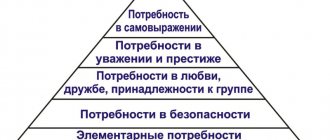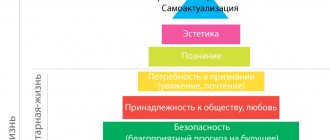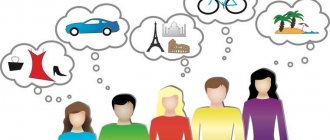Updated July 23, 2021 208 Author: Dmitry Petrov
Hello, dear readers of the KtoNaNovenkogo.ru blog. From birth we experience different needs (for food, sleep, air, care).
Over time, they change, are supplemented, and strengthened. But it is their satisfaction that makes us act, move forward, go towards the goal.
Today we will talk about what it is, find out what needs are inherent in each person, what types they are divided into, and also take a detailed look at the pyramid of human needs from the famous American psychologist Abraham Maslow.
Principles of Maslow's pyramid
Psychologist Abraham Maslow, who worked in the USA in the 20th century, argued that human needs have a hierarchical structure and depend on each other: the satisfaction of each of them entails an increase in ambitions and the emergence of new interests. For example, a person’s financial capabilities do not allow them to meet basic needs: food, their own housing, security. At this stage, a person is worried about survival, he has neither the strength nor the capabilities for further development. Having achieved a stable income and bought their own home, a person begins to think about traveling, starting a family and purchasing courses to improve professional skills.
The more needs are covered, the higher and freer the aspirations and possibilities. To move to a new level, a person needs to close the needs related to the previous one, but variations are possible here. Maslow emphasized that the principle of distribution of needs may depend on the psychological type of a person. In the value system of an active careerist, family will occupy the last place, and for a creative person, spiritual development is more important than position in society. Some people are not interested in developing higher needs, being content with little, but such changes occur as a result of unfavorable living conditions or under the influence of aggressive external factors.
The essence of the concept
Every person needs something. Everything depends on the living conditions, the individual’s activities, material objects, etc. This is the individual’s need. That is, this is the internal state of a person, because of which something is felt to be insufficient. The need manifests itself differently for everyone, depending on certain situations. Experts have noticed that the need never ends. If a person has satisfied one need, another immediately appears. This cycle happens throughout life. Each need is manifested by certain emotions. A person becomes angry and irritable when he cannot satisfy a need, that is, negatively disposed. Positive emotions only appear when everything has worked out.
If needs are not met, discomfort appears, which gradually develops into a negative state. That is why people try to create all the conditions for a comfortable and prosperous life. Every living organism needs something. This is not necessarily a person, but also plants, animals, insects and other living creatures. The concept and classification of needs are considered in diverse aspects. However, psychologists associate them with human needs in different areas and directions. This is the essence of every need.
Maslow's pyramid structure
The classic pyramid of needs, according to Maslow’s 1954 work “Motivation and Personality,” includes 5 levels. The main goal of a person is to achieve the fifth level, which is equivalent to the closure of all vital needs.
Level No. 1. Physiological needs
At this stage, it is important to satisfy physiological needs , without which it is simply impossible to lead a normal life:
- satisfying hunger and thirst;
- roof over your head;
- minimal rest, healthy sleep.
This level can be characterized in one phrase: “I got enough sleep, I’m not hungry, I’m not thirsty.” Meeting physiological needs is the basis from which the next levels of the pyramid grow.
Maslow's classic pyramid
Level No. 2. Safety
After satisfying physiological needs, a person needs security. This group includes:
- stability in all areas of life and in the psycho-emotional state;
- confidence in the absence of external threats and dependence;
- consistency in comfort and living conditions.
A person who has reached level 2 of the pyramid is devoid of anxiety, he experiences a certain amount of confidence and is not afraid of global changes.
Level No. 3. Social connections
Man is a social being, therefore, for a comfortable life he needs the following psychological beacons:
- faithful friends;
- support, understanding, care;
- loving family: husband/wife, child/children;
- social contacts with interesting people;
- business partners you can rely on;
- stable social circle.
At this level, it is important for a person to know that he is not alone and belongs to a certain social group.
Level No. 4. Prestige
A person needs a positive assessment, because he has gone through a lot and put a lot of effort into development. At this stage, the main priorities are:
- high social status;
- professional achievements;
- encouragement from colleagues, management, family and friends;
- feeling of self-importance;
- respect, glory, power;
- acquiring a positive reputation.
Recognition of achievements achieved in one area or another is necessary.
Level No. 5. Spirituality (self-actualization)
A person at this level does not experience material problems, he has acquired status and is socially realized, so it’s time to think about self-actualization. There is time to develop spiritual qualities, talents or areas in which there is interest. For example, a person is a successful programmer, but all his life he wanted to learn how to draw - he will satisfy this need after achieving all the others included in the pyramid. There is an improvement of personality, there is a desire for self-expression. In accordance with the works of Oil, no more than 1.5-2% of the Earth's population moves to this level.
Functions
There are three stages that determine a person's needs. First, a need is formed when a person has a certain attitude, feelings and emotions towards external stimuli. Then motivation is built, and the third stage is awareness of the need. At the same time, a person experiences negative or positive emotions, specific thoughts, goals and plans appear.
There are two main functions:
- Signal. When a need arises, a person feels a shortage, thoughts change, and the state becomes more restless until the need is satisfied.
- A driving need. The individual begins to act in his own interests. Activity and work activity manifest themselves, and a person’s behavior changes radically.
In fact, the classification of human needs closely intersects with functions. However, only a few species have been described. Many psychologists count more than 130 human needs. This is a lot, but people still strive to live better and satisfy their needs with both material and spiritual benefits. The same can be said about the needs of society.
Maslow's Extended Pyramid
In later works, the pyramid was supplemented with two levels, located between prestige and spirituality:
- cognitive needs: knowledge, skills, desire for research, creation. There is a desire to learn, gain new knowledge and expand the range of hobbies;
- aesthetic needs: beauty, harmony, order. A person feels a desire to travel, visit exhibitions and museums, develop culturally, enjoy the beauty of nature and peace of mind.
Abraham Maslow developed only the theory of needs; it was put into table form by other scientists (about 15-20 years after the publication of the scientific works of the American psychologist). Over the years, the pyramid has not lost its relevance; today it is used by analysts, marketers and other sales representatives who seek to better understand potential buyers.
Maslow's Extended Pyramid
Pros and cons of Maslow's pyramid
Maslow's pyramid has a number of advantages that are valuable not only for psychologists, but also for marketers:
- better understanding of customer needs and values;
- building the right sales strategy and marketing campaigns;
- optimization of marketing processes related to segmentation of the target audience and the formation of a unique selling proposition;
- correct assessment of personal perception characteristic of different groups of clients;
- objective comparison of life priorities.
Some principles of Maslow's pyramid are considered outdated: all needs included in the structure cannot be satisfied. However, Maslow's pyramid is the basis from which Alderfer's ERG (three needs) theory and other classification systems were developed.
How to Use Maslow's Needs Theory in Marketing
Development of commercial and unique selling propositions
Having identified the client's needs, the business will be able to speak the same language with him. For example, an online store delivers ready-made food. The store's customers are people who want to quickly satisfy their hunger after a hard day at work or returning from a business trip. They are not ready to wait for a long time, so the advertising campaign is based on the slogans “We will deliver in 30 minutes”, “Get your order for free if it is not delivered within 1 hour”, “A quick snack like grandma’s” and others. It makes no sense to offer gourmet delicacies to a person who plans to quickly eat pizza while in the middle of a traffic jam.
Clients of online stores selling expensive jewelry or watches gravitate towards elements of prestige. Because of this, marketing campaigns for high-budget products use the words “unique,” “premium,” and “limited editions.” After determining the client’s place in the pyramid, you can develop proposals that will work effectively here and now, reflecting the specifics of the business and leveling objections.
Adaptation to changing customer requirements
The needs of potential buyers are changing, due to the growth of sales markets and the introduction of new services. Over the past 10 years, messenger marketing, door-to-door delivery, augmented reality applications, and online tools on websites that allow you to calculate prices or select clothing sizes have gained popularity. If an online store cannot offer in-demand services, then customers will go to competitors. The formation of new proposals is carried out on the basis of needs analysis.
Gaining loyalty
Elements of Maslow's pyramid are often integrated into loyalty marketing strategies. They are based on three basic principles that have similar features to the theory of needs:
- at the first level, the client goes through transactional loyalty: he chooses a product, service or services, receiving benefits. The customer spends money, but at the same time, physiological needs are met and a feeling of security is formed, consonant with confidence in the seller;
- By moving to the second level of the program, the client receives recognition. The online store has a comprehensive amount of information about the buyer, and he receives more benefits, which is an incentive to increase loyalty. The client develops a feeling of mutual respect and social belonging;
- working with customer experience. The online store satisfies the client’s obvious and hidden needs, for which he makes purchases and returns to the seller again. The buyer feels important, he is ready to work for the benefit of the company, so he starts active word of mouth.
By guiding the client through all stages, the marketer has the opportunity not only to start the sales process, but also to acquire a loyal customer who will willingly advertise the brand or company. Based on this data, loyalty programs, referral programs and sales funnels, as well as advertising campaigns (contextual, social networks, etc.) are formed.
Lowest platform
Physiological needs can be satisfied throughout your life and never be satisfied. Pathology and displacement of value orientations, as a rule, occur in many members of modern society (regardless of wealth and social significance). And all these problems are due to the exaltation and highlighting of lower needs. This is how dissatisfaction with oneself and one’s life, destiny, and place in society comes. Lack of understanding of your role in life. The result is a low social role, a feeling that you are a cog in a machine, a piece of gray mass, causing oppression and a feeling of hopelessness.
How to determine client needs using Maslow's pyramid
The following tools are used to determine client needs:
- drawing up a client portrait using Sherrington’s 5W method. The marketer collects information about who the client is, what exactly the business offers, where and under what conditions they will buy this product;
- analysis of consumer interests. An analysis of reactions to different advertising messages is carried out, a map of the client’s journey and click dynamics are studied;
- surveys to identify pain points, budget, needs, age and other individual characteristics of customers from different segments.
Surveys can be conducted on social networks, in a playful way through quizzes, or using Google Forms.
You can ask the client about his needs and expectations directly ; a good solution would be to collect information about the experience of using a similar product and shopping in other online stores. The collected data is systematized, after which the target audience is segmented and campaigns are developed that meet the expectations and interests of each group.











